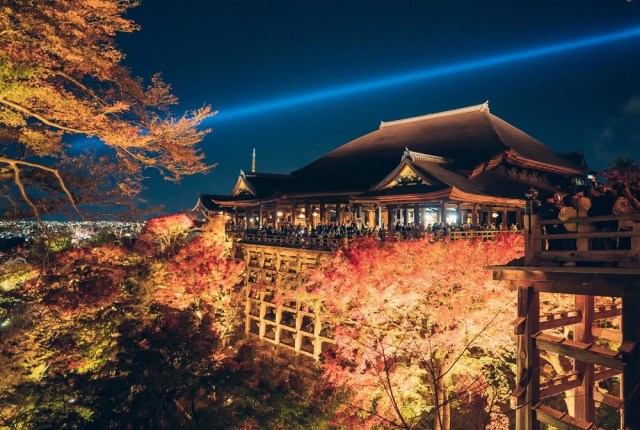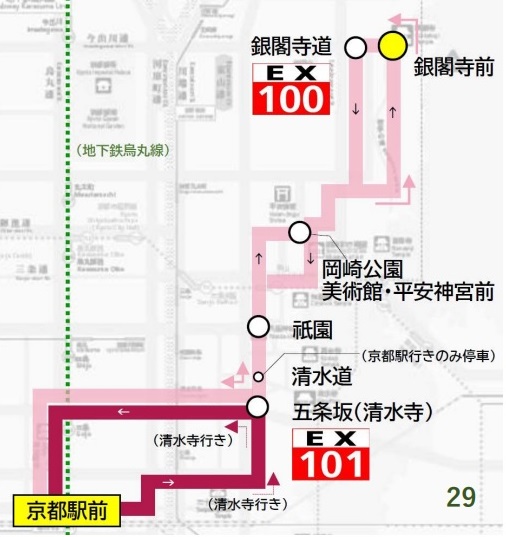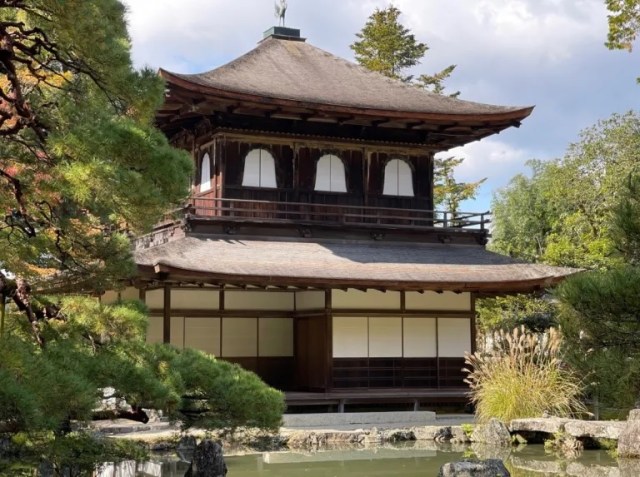
A win-win idea that’s long overdue.
In recent years, the issue of overtourism has been getting increasing amounts of attention in Kyoto. The city was already one of Japan’s most popular travel destinations for both domestic and international tourists, and with the weak yen and pent-up post-pandemic travel desire casing an especially large surge in inbound international visitors, the Kyoto Municipal Transportation Bureau has decided to take action by creating special Tourism Express Bus routes.
Buses have been among the places where tourism most visibly bumps up against locals’ lifestyles. Despite its image as a quiet, cultured community, Kyoto is not a small city, having a population of close to 1.5 million people. However, Kyoto’s train and subway network is fairly compact, with most of its rail stops clustered in a relatively small area in the center of downtown. That means many locals who live outside the very center of the city and are reliant on public transportation need to take the bus.
At the same time, most of Kyoto’s biggest tourism draws are also located outside the rail network, on the outer fringes of the downtown area, and some are also nestled against the foothills on the eastern edge of town, limiting the angles they can be approached from. Those factors regularly funnel tourists onto the same buses that local residents use to get around, more so than in just about any other large Japanese city. The result has been increasingly crowded buses, sometimes so much so that there’s not enough room to even get on unless you wait for multiple buses to come by.
Obviously, that isn’t a situation that locals or travelers enjoy, and a year ago the Kyoto city government announced that it would no longer be offering its popular 700-yen (US$4.70) one-day all-you-can-ride bus passes to address overcrowding, instead bundling a day’s worth of unlimited subway and bus rides together in an 1,100-yen combo pass. As mentioned above, though, many of Kyoto’s most popular sightseeing attractions have no nearby subway stops, and so buses have remained crowded. So on Thursday, the Kyoto transportation bureau announced that it will be starting a pair of Tourism Express Bus routes this summer, specifically designed for travelers, to help divert them away from buses being used by locals.
▼ Tourism Express Bus routes, with the Kyoto Station stop (京都駅前) marked in yellow (note that the bus only stops at Kiyomizumichi (清水道) on its way back to Kyoto Station).
The Tourism Express Buses will run on weekends and holidays, with both routes starting at Kyoto Station. The longer route, designated EX100, will depart from Kyoto Station and head east into the Higashiyama district, with its first stop at Gojozaka, down the hill from Kiyomizu Temple. The bus will then travel north to its next stop at Gion, Kyoto’s famed geisha quarter, and then to a combined stop for Heian Shrine, Okazaki Park, and the Kyoto Museum of Art. After that, the bus goes further north to Ginkakuji (a.k.a. the Silver Pavilion), stopping once in front of the site and again nearby at Ginkakuji-michi, from where it turns back for the return to Kyoto Station, making one additional stop at Kiyomizu-michi, at the base of the slop that leads to Kiyomizu Temple. A shorter route, EX101, stops only at Gojozaka before heading back to Kyoto Station. 24 EX100 buses and 16 EX100 will run daily, approximately three each per hour between 9 a.m. and 4 p.m. The new routes will begin running on June 1.
▼ Ginkakuji, located near the northernmost stop on the Tourism Express Bus route
The creation of the Tourism Express Buses doesn’t mean that travelers are barred from using ordinary buses, and locals are likewise allowed to use the nominally for-tourist routes too. Two aspects will likely result in a natural divergence of local and tourist ridership, though.
First, as you can see from the above map, there aren’t a ton of stops on the Tourism Express Bus route. Yes, tourists can easily spend a full-day sightseeing at the spots it provides access to, especially since Ginkakuji is connected to a handful of other temples via the Philosopher’s Path walking street. The absence of stops in any major office, shopping, or residential areas, though, means that there’s little reason for locals to take the Tourism Express Bus while going about their everyday, non-sightseeing lives.
The other divergence factor is the price. A ride on the Tourism Express Bus will cost 500 yen (US$3.35), or 250 yen for children. That’s double the flat fee charged for a ride on normal Kyoto city buses, and while that extra amount is miniscule difference when folded into an entire trip-to-Kyoto/Japan travel budget, residents who are taking the bus dozens or hundreds of times a year will presumably gravitate towards the less expensive standard bus options.
There’s a possibility that extra-thrifty travelers may still feel the allure of the cheaper normal buses, but the smaller number of stops on the Tourism Express Bus routes also mean a shorter ride to the destinations along the way. From Kyoto Station, the ride to Gojozaka is expected to shrink to just 10 minutes, down from the 15 it takes on a normal bus, and the time from Kyoto Station to Ginkakuji is cut almost in half, at only 24 minutes compared to the regular 44. The Tourism Express Bus will also be covered by the 1,100-yen one-day Kyoto bus/subway pass.
One could argue that it’s strange that the Tourism Express Buses will cost more to ride, especially with the truncated EX101 route being so short. After all, if the whole reason they’re being created is because there are so many tourists, it seems there should be enough of an economy of scale to price the Tourism Express Buses like any other. As discussed above, though, the price difference is likely to help separate local and tourist use.
Quibbles about pricing aside, the Tourism Express Bus seems like an idea that’s long overdue. Kyoto has always been a city that attracts travelers, going back to the days when its status as Japan’s capital city made it not just the center for lofty fine arts, but for commerce and commoners’ pursuits too. Its rising popularity as a travel destination continually contributes to an international appreciation and affinity for Japan, and so an initiative like this to help Kyoto continue to be a showcase of Japan’s traditional culture to people from all over the world while still remaining a livable city for those who call it home.
Source: Kyoto City (1, 2)
Top image: Pakutaso
Insert images: Kyoto City, SoraNews24
● Want to hear about SoraNews24’s latest articles as soon as they’re published? Follow us on Facebook and Twitter!



 Kyoto wants to add extra charges for tourists to use city buses
Kyoto wants to add extra charges for tourists to use city buses One thing NOT to do in Kyoto if you’re headed there during the vacation period
One thing NOT to do in Kyoto if you’re headed there during the vacation period Japanese travelers are avoiding Kyoto as the city’s number of foreign visitors continues to grow
Japanese travelers are avoiding Kyoto as the city’s number of foreign visitors continues to grow No water, no cooking oil, no yogurt: The new strict bus rules in Urumqi, China
No water, no cooking oil, no yogurt: The new strict bus rules in Urumqi, China New self-driving buses testing across Japan let you pay with your face
New self-driving buses testing across Japan let you pay with your face Japan’s new difficult-to-drink-from beer glass protects your liver, but it’s a brutal experience
Japan’s new difficult-to-drink-from beer glass protects your liver, but it’s a brutal experience New Nintendo Lego kit is a beautiful piece of moving pixel art of Mario and Yoshi【Photos】
New Nintendo Lego kit is a beautiful piece of moving pixel art of Mario and Yoshi【Photos】 Come play hide-and-seek on a deserted Japanese island this August and November
Come play hide-and-seek on a deserted Japanese island this August and November To combat declining birth rate, Japan to begin offering “Breeding Visas” to foreigners
To combat declining birth rate, Japan to begin offering “Breeding Visas” to foreigners How to order snacks on a Shinkansen bullet train in Japan
How to order snacks on a Shinkansen bullet train in Japan Demon Slayer: Kimetsu no Yaiba gets new roller coaster attractions and food at Universal Studios Japan
Demon Slayer: Kimetsu no Yaiba gets new roller coaster attractions and food at Universal Studios Japan High-fashion Totoro cuddle purse is like an elegant stroll in the forest【Photos】
High-fashion Totoro cuddle purse is like an elegant stroll in the forest【Photos】 New Pokémon ice cream, dessert drinks, and cool merch coming to Baskin-Robbins Japan【Pics】
New Pokémon ice cream, dessert drinks, and cool merch coming to Baskin-Robbins Japan【Pics】 Hello, cosmetics! Clinique teams up with Hello Kitty this summer for first-time collaboration
Hello, cosmetics! Clinique teams up with Hello Kitty this summer for first-time collaboration We check out the local flavors of the commonly confused Ome and Aomi areas of Tokyo in one day
We check out the local flavors of the commonly confused Ome and Aomi areas of Tokyo in one day Nintendo history you can feel – Super NES, N64, and GameCube controllers become capsule toys
Nintendo history you can feel – Super NES, N64, and GameCube controllers become capsule toys “The most Delicious Cup Noodle in history” – Japan’s French Cup Noodle wins our heart【Taste test】
“The most Delicious Cup Noodle in history” – Japan’s French Cup Noodle wins our heart【Taste test】 Starbucks releases a cute Frappuccino and Unicorn Cake…but not in Japan
Starbucks releases a cute Frappuccino and Unicorn Cake…but not in Japan Kyoto Tower mascot termination reveals dark side behind cute Japanese characters
Kyoto Tower mascot termination reveals dark side behind cute Japanese characters McDonald’s Japan’s Soft Twist Tower: A phantom ice cream only sold at select branches
McDonald’s Japan’s Soft Twist Tower: A phantom ice cream only sold at select branches Yabai Ramen: What makes this Japanese ramen so dangerous?
Yabai Ramen: What makes this Japanese ramen so dangerous? Finally! Nintendo Japan expands Switch 8-bit controller sales to everybody, Online member or not
Finally! Nintendo Japan expands Switch 8-bit controller sales to everybody, Online member or not Japanese government wants to build luxury resorts in all national parks for foreign tourists
Japanese government wants to build luxury resorts in all national parks for foreign tourists 10 things you should buy at 7-Eleven in Japan
10 things you should buy at 7-Eleven in Japan Studio Ghibli releases anime heroine cosplay dresses that are super comfy to wear
Studio Ghibli releases anime heroine cosplay dresses that are super comfy to wear Woman charged for driving suitcase without a license in Osaka
Woman charged for driving suitcase without a license in Osaka Studio Ghibli unveils My Neighbour Totoro miniature house model
Studio Ghibli unveils My Neighbour Totoro miniature house model Kyoto experiencing problems with foreign tourists not paying for bus fares, but not on purpose
Kyoto experiencing problems with foreign tourists not paying for bus fares, but not on purpose Fighting mild hunger with a Japanese soda that turns into jelly in the stomach【Taste test】
Fighting mild hunger with a Japanese soda that turns into jelly in the stomach【Taste test】 Studio Ghibli’s Howl’s Moving Castle tapestry unveiled in Japan for first time
Studio Ghibli’s Howl’s Moving Castle tapestry unveiled in Japan for first time McDonald’s new Happy Meals offer up cute and practical Sanrio lifestyle goods
McDonald’s new Happy Meals offer up cute and practical Sanrio lifestyle goods Sales of Japan’s most convenient train ticket/shopping payment cards suspended indefinitely
Sales of Japan’s most convenient train ticket/shopping payment cards suspended indefinitely Sold-out Studio Ghibli desktop humidifiers are back so Totoro can help you through the dry season
Sold-out Studio Ghibli desktop humidifiers are back so Totoro can help you through the dry season Japanese government to make first change to romanization spelling rules since the 1950s
Japanese government to make first change to romanization spelling rules since the 1950s Foreigner’s request for help in Tokyo makes us sad for the state of society
Foreigner’s request for help in Tokyo makes us sad for the state of society Ghibli founders Toshio Suzuki and Hayao Miyazaki contribute to Japanese whisky Totoro label design
Ghibli founders Toshio Suzuki and Hayao Miyazaki contribute to Japanese whisky Totoro label design Doraemon found buried at sea as scene from 1993 anime becomes real life【Photos】
Doraemon found buried at sea as scene from 1993 anime becomes real life【Photos】 Tokyo’s most famous Starbucks is closed
Tokyo’s most famous Starbucks is closed Princesses, fruits, and blacksmiths: Study reveals the 30 most unusual family names in Japan
Princesses, fruits, and blacksmiths: Study reveals the 30 most unusual family names in Japan Narita Airport shuttle buses – Cheaper than the train, but which bus is best?
Narita Airport shuttle buses – Cheaper than the train, but which bus is best? Kyoto study finds nearly 500 translation errors for foreign tourists, new guidelines released
Kyoto study finds nearly 500 translation errors for foreign tourists, new guidelines released Kyoto may be getting more modern, tall buildings as city relaxes development limits
Kyoto may be getting more modern, tall buildings as city relaxes development limits A visit to T-CAT, Tokyo’s often forgotten City Air Terminal【Photos】
A visit to T-CAT, Tokyo’s often forgotten City Air Terminal【Photos】 Iconic Kyoto Tower bathhouse closes due to coronavirus
Iconic Kyoto Tower bathhouse closes due to coronavirus Kyoto tourist crowds disappearing due to coronavirus outbreak, creating travel crisis/opportunity
Kyoto tourist crowds disappearing due to coronavirus outbreak, creating travel crisis/opportunity Japan’s ultra-classy overnight bus gives you your own sleeping pod【Photos】
Japan’s ultra-classy overnight bus gives you your own sleeping pod【Photos】 Japan’s Shachi Bus offers tour with no destination or leaving the bus, but something’s fishy…
Japan’s Shachi Bus offers tour with no destination or leaving the bus, but something’s fishy… Nine things that may shatter your dreams of living in Kyoto
Nine things that may shatter your dreams of living in Kyoto Breathtakingly beautiful beach in often-overlooked part of Japan is like a scene out of Your Name
Breathtakingly beautiful beach in often-overlooked part of Japan is like a scene out of Your Name Hike from the sea to the peak of Mt. Fuji with new bilingual English/Japanese guide map series
Hike from the sea to the peak of Mt. Fuji with new bilingual English/Japanese guide map series It’s pretty amazing buses in this Japanese town don’t crash into this mountain every day【Video】
It’s pretty amazing buses in this Japanese town don’t crash into this mountain every day【Video】 Tokyu Bus alight button is yours to own, pushing all the right buttons
Tokyu Bus alight button is yours to own, pushing all the right buttons Japanese government wants to encourage wealthy foreigners to travel deeper into Japan, NHK says
Japanese government wants to encourage wealthy foreigners to travel deeper into Japan, NHK says Tokyo’s new buses with onboard capsule toy gacha machines stocked with very appropriate prizes
Tokyo’s new buses with onboard capsule toy gacha machines stocked with very appropriate prizes
Leave a Reply